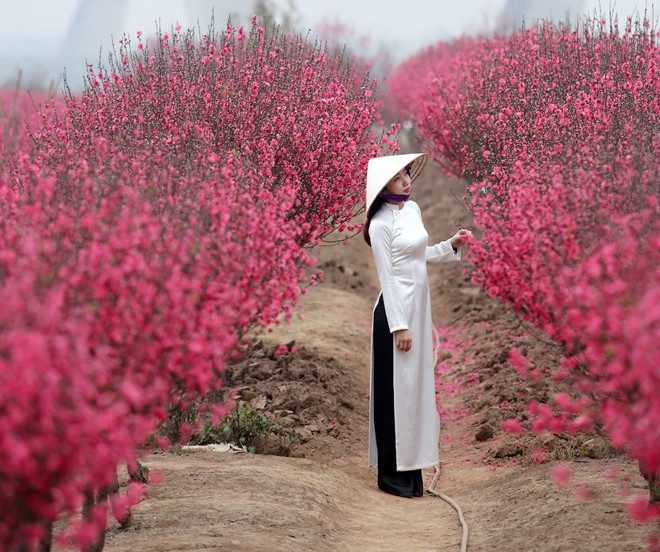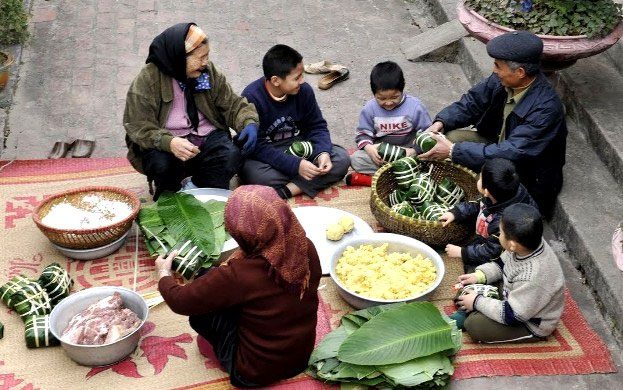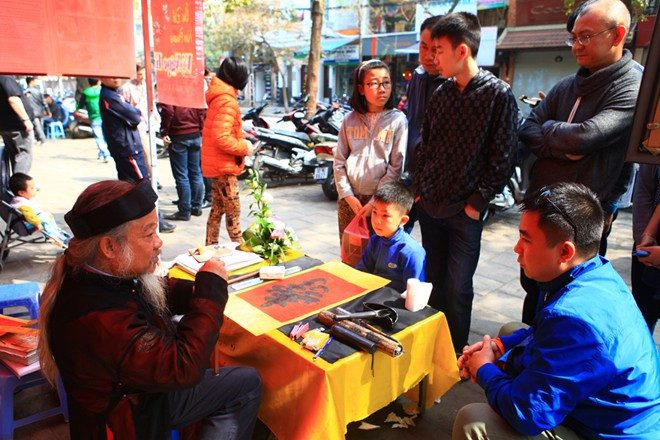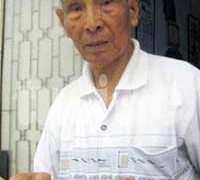Buying peach and kumquat trees, preparing five-fruit trays, housewarming rituals, buying salt, giving lucky money, requesting calligraphy, and visiting temples are traditional customs that bring luck and blessings during the Tet holiday in Vietnam.
15 Traditional Customs for a Lucky New Year
- Sending Off the Kitchen Gods
- Visiting Ancestral Graves
- Bidding Farewell to the Old Year and Welcoming the New
- Customs of Peach, Kumquat, and Apricot Trees
- Arranging the Five-Fruit Tray
- Wrapping Banh Chung and Banh Tet
- Erecting the Nêu Tree
- Welcoming the New Year
- Housewarming Ritual
- First Departure of the Year
- Giving Lucky Money and Year-End Wishes
- Requesting Calligraphy at the Beginning of the Year
- Buying Salt at the Beginning of the Year
- Temple Visits for Good Fortune
- Picking Auspicious Leaves
Tet Nguyen Dan is a significant event for the Vietnamese people. The traditional customs during this time carry deep meanings, with the hope of bringing luck and blessings for a peaceful and prosperous new year.
Sending Off the Kitchen Gods
According to tradition, on the 23rd day of the last lunar month, the Kitchen Gods ascend to heaven to report on the household affairs to the Jade Emperor. Therefore, on this day, Vietnamese families clean their kitchens thoroughly and buy golden fish for offerings to send the Kitchen Gods to heaven. Nowadays, this custom has evolved, with many families gathering at places like temples or rivers to perform the ritual together.
Visiting Ancestral Graves
Descendants often visit their ancestral graves from the 23rd to the 30th of the last lunar month, cleaning and tidying up to express their filial piety and invite the spirits of their ancestors to return with them. This is a common tradition among Vietnamese people, demonstrating respect towards their ancestors. Depending on beliefs or religions, the day of grave visiting may vary, but the underlying purpose is to honor their roots.
Bidding Farewell to the Old Year and Welcoming the New
During the last days of the year, Vietnamese people have the custom of cleaning their homes and buying new items and clothes. Adults remind their children that during this transition, there should be no arguments, blame, or mistakes. Those with grievances also reconcile, and during the New Year moment, they only wish each other good things, ensuring everything is in the best state to welcome new guests in the coming year.
Customs of Peach, Kumquat, and Apricot Trees
Families in Northern Vietnam often cannot do without a peach branch during the Tet season. The vibrant pink color of the peach blossoms creates a joyful spring atmosphere and symbolizes the expulsion of evil spirits, bringing luck in the new year. The most popular type of peach is the pink peach with large, many-petaled flowers.

The bright pink peach blossoms. (Photo: Vu Minh Quan/Zing).
At the same time, the kumquat tree is also an essential feature of Tet. A beautiful kumquat tree is lush, with a nice canopy, golden fruits, young fruits, and vibrant green leaves, symbolizing prosperity and wealth.
In Southern Vietnam, due to climatic conditions, people often use apricot trees instead of peach and kumquat. The bright yellow of the apricot flowers symbolizes glory, success, and growth. People often choose trees with many buds and blossoms before Tet, as the belief is that flowers blooming right at the New Year’s Eve or early on the first day will bring good luck, prosperity, and happiness for the family throughout the year. Apricot flowers usually have five petals, but some have six, seven, or even ten petals. The more flowers and petals the tree has, the luckier the household will be in the new year.
Arranging the Five-Fruit Tray
The five-fruit tray is an indispensable custom for Vietnamese people during the New Year. “Five” symbolizes life, as in the five elements, five flavors, five colors, five organs, etc. Fruits represent abundance and fertility. Each region has different ways of arranging the five-fruit tray, but they all select fruits with special meanings.
In the South, the common fruits include custard apple, coconut, papaya, and mango, which can be read as “enough for use” with the hope of a prosperous new year. Additional fruits like watermelon, apples, and peaches are also included.
The Northern five-fruit tray cannot lack green bananas, symbolizing spring, wood, and serving as a protective hand that shelters and gathers luck. Buddha’s hand or pomelo represents earth, wishing for blessings in abundance. Red fruits like oranges, tangerines, and apples represent fire, while white fruits like guava and peaches symbolize metal, and black fruits like plums and sapodilla represent water. A complete five-fruit tray, balanced and fulfilling, ensures favorable conditions and good fortune.
Wrapping Banh Chung and Banh Tet
Banh Chung and Banh Tet are an essential part of Vietnamese cultural beauty. Every year around the 27th, 28th, or 29th of Tet, families gather together to wrap these traditional cakes.

Wrapping Banh Chung and Banh Tet is an essential part of Vietnamese culture.
In the South, Banh Tet is cylindrical, while in the North, Banh Chung is square. Although they differ in shape, the ingredients are the same, with rice being the main component, symbolizing the long-standing rice culture of the Vietnamese people.
This tradition dates back to the time of the Hung Kings and remains an unchangeable part of Tet culture. Every family must wrap dozens of cakes to honor their ancestors, gift friends and relatives, or enjoy during Tet. Wrapping Banh Chung is a moment to remember one’s roots, providing time for everyone to gather, share stories about the past year, and hope for a fulfilling new year. The rounder the Banh Tet and the squarer the Banh Chung, the more abundant, prosperous, and successful the new year will be.
Erecting the Nêu Tree
Traditionally, every year during the New Year, evil spirits come to disrupt the festivities, so to ward off evil spirits and misfortune, a Nêu tree is erected to signal that this place has an owner, and spirits are not allowed to disturb.
The Nêu tree is a bamboo pole about 5 to 6 meters tall, often adorned with gold and silver paper, talismans, and rice wine wrapped in straw at the top, along with a small lantern. This serves as a means to repel evil spirits and misfortune, while also lighting the way for ancestors to return home and celebrate Tet with their descendants. The Nêu tree is erected from the 23rd of the last lunar month until the 7th of the first lunar month, when it is taken down.
Welcoming the New Year
This is the moment that marks the transition from the old year to the new, a sacred time when heaven and earth harmonize. Welcoming the New Year takes place at the final moment of the old year, symbolizing the shedding of all bad things from the previous year and the welcoming of all good things from the new year. The New Year offering ceremony must be performed outdoors.
Housewarming Ritual
Vietnamese people believe that the first person to enter the house after New Year’s Eve or on the first day of Tet will determine the fortune for the entire year. The person invited to perform this ritual is often someone compatible with the household’s zodiac, healthy, successful, and good-natured, with the hope that they will bring luck to the whole family. The guest will visit the house and wish the host good things. The guest themselves also receives blessings for performing a good deed.
First Departure of the Year
On the first day of the year, Vietnamese people often choose an auspicious time and direction to set out, hoping for a lucky year every time they leave the house.
Giving Lucky Money and Year-End Wishes
On the first morning of Tet, it is common for children and grandchildren to gather to wish longevity to their grandparents and parents, expressing their filial piety and respect for the elders in the family. Children receive red envelopes containing new money, referred to as “opening money,” to encourage growth, joy, and luck in the new year. The amount of money is not important; rather, its significance is what matters.

A calligrapher explains the meaning of the written characters. (Photo: Viet Quan).
Requesting Calligraphy at the Beginning of the Year
This is a beautiful cultural tradition of the Vietnamese, symbolizing the importance of education and literacy. People often visit the homes of elders, temples, or the Temple of Literature to request beautifully written characters with positive meanings like Fortune, Wealth, and Virtue… in hopes of a lucky and fulfilling new year. The graceful, artistic calligraphy on red or yellow paper symbolizes both spiritual significance and adds a solemn atmosphere to the spring season.
The Tradition of Buying Salt at the Beginning of the Year
“At the beginning of the year, buy salt; at the end of the year, buy lime.” This phrase is certainly well-known among the Vietnamese people. According to ancient beliefs, salty food is thought to ward off evil spirits, bring good fortune, and symbolize strong, enduring relationships. Therefore, at the start of the year, vendors selling salt can be found everywhere, allowing families to buy a full bowl of salt, symbolizing their wishes for a peaceful and prosperous new year, with harmony and closeness among family members.
The Custom of Visiting Temples to Pray for Good Luck
This custom is an essential spiritual activity during the Lunar New Year for the Vietnamese people. Typically, after the final meal of the year, women in the family prepare offerings and go to the nearest temple to pray for blessings. Instead of picking buds, people nowadays often purchase sugarcane, camellia flowers, or branches of new growth to bring good luck home for their families. At the beginning of the year, many also embark on spring trips to famous pilgrimage sites to pray for health and prosperity for their families.
Picking Buds
Picking buds at the beginning of the year is a beautiful traditional practice for the Vietnamese during the New Year. This activity is usually performed on New Year’s Eve or the early morning of the first day of the Lunar New Year to attract good fortune and welcome blessings into the home.




















































